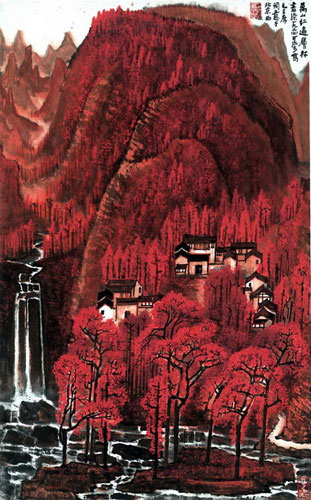Last week, an auction in China brought to the fore an artist whose name we probably ought to know: Li Keran.
His Thousands of Hills in A Crimsoned View, which was inspired by a poem written by Mao Zedong and was painted in 1964, fetched $46 million at Beijing Poly.
 As Jing Daily, which reported the sale, noted, Li is not a household name even in China, and the work was purchased by “a domestic entrepreneur who began buying art two years ago.†It came, however, from “overseas.”
As Jing Daily, which reported the sale, noted, Li is not a household name even in China, and the work was purchased by “a domestic entrepreneur who began buying art two years ago.†It came, however, from “overseas.”
I know some people say, with apparently good reason, that figures coming out of China are not all that they’re cracked up to be. I also know that we should not judge art by a value determined by the marketplace.
But, I think we ought to know about Li because I tend to agree with something I read recently to The New York Times.  In an article published on Apr. 23, headlined “China Extends Reach Into International Art,” Fan Di’an, director of the National Art Museum of China, was quoted saying: “For the Western point of view, the 20th century is Western art, and the art of Modernism. I don’t think that is fair. These days, when Western scholars discuss modernity, they should also discuss Chinese modernity.”
Some people do know Li. In the ArtPrice report on the 2011 art market, which I reported on here (read the comments — some people dispute numbers coming from China), Li Keran was No. 10 on the “Top Ten Artists,” defined as a global ranking of artists by auction revenue during 2011. Here is that list:
- Zhang Daqian (1899-1983) – $550m
- Qi Baishi (1864-1957) – $510m
- Andy Warhol (1928-1987) – $325m
- Pablo Picasso (1881-1973) – $315m
- Xu Beihong (1895-1953) – $220m
- Wu Guanzhong (1919-2010) – $212m
- Fu Baoshi (1904-1965) – $198m
- Gerhard Richter (1932) – $175m
- Francis Bacon (1909-1992) – $129m
- Li Keran (1907-1989) – $115m
How many of the non-Western artists can you call up an image for?
Regarding Li, here’s what ArtPrice wrote:
Just outside the top 10 last year, Li Keran took tenth place in the 2011 ranking. The sixth Chinese artist and perhaps, so far, the least well-known in the West, with only 5 of his works selling outside Asia in 2011. Although there was no new record for Li Keran last year, he generated his fourth and fifth best results (Landscape in 1979 sold for $5.1 million and Maple woods on Mt. Danxia 1963 fetched $5 million) and his works attract a not particularly selective type of demand: only 13% of his lots failed to sell in 2011. One of the Chinese Moderns, Li Keran mixed traditional ink and accumulations of colours, creating a sense of depth and perspective. His technique reflected his apprenticeship and his mastery of Chinese landscape painting, but also Western influences. The artist’s market is primarily in mainland China where 90% of his revenue is generated. Paintings by the artist seldom travel, and should become increasingly rare on the market, especially after the artist’s widow donated over a hundred paintings to the Chinese government. His progress this year is well deserved considering that in 2001, only 12 years after his death, when the National Museum of Hong Kong organised a major retrospective of his work, Li Keran was already in Artprice’s Top 500… at the 345th place. China’s power on the art market has in effect swept Keran all the way to the Top 10.
Now he does have a record price. It’ll be interesting to see next year’s Top Ten from ArtPrice.
Photo Credit: Courtesy of Jing Daily
